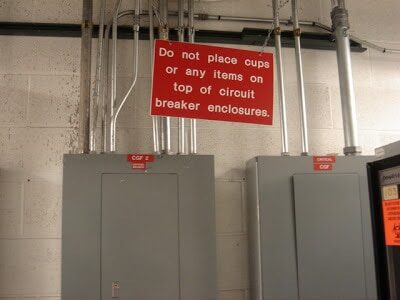I saw this at a hospital lab last year, a great example of true error proofing vs. just putting up warning signs. “Cautions” and “Warnings” are lazy engineering, in general, with product design. Signs are not good problem-solving in any process environment; they fall far short of true error-proofing.
Image #1 was just outside the lab:

I'm sure putting beverages or liquids on top of the circuit break enclosures poses a lot of risk. I'm guessing that spilling would short out things, causing major downtime or maybe even an injury. The sign doesn't prevent anything. Signs are too easily ignored.
Furthermore, the sign doesn't explain “Why” you shouldn't put cups up there. As I've blogged about before, a key point of the Toyota Production System is the power of EXPLAINING “why” to people, not just asking “why?” This point is often overlooked or not talked about. Part of the “respect for people” notion is realizing that they are smart enough to do the right thing if you explain it. This sign says “don't do it… because management says so.”
Photo 2 was in a different hallway, some employee lockers, like you might see at a high school. Can anyone put items up on top? No! Because the top of the lockers isn't flat. It's error proofed. Items would just fall off. No sign required!

Think about your workplace. How often do you rely on warning signs, caution signs, or “because I said so” signs? Error proofing requires a little bit of creativity, but it's worth it. What solutions can you come up with?
Please scroll down (or click) to post a comment. Connect with me on LinkedIn.
Let’s work together to build a culture of continuous improvement and psychological safety. If you're a leader looking to create lasting change—not just projects—I help organizations:
- Engage people at all levels in sustainable improvement
- Shift from fear of mistakes to learning from them
- Apply Lean thinking in practical, people-centered ways
Interested in coaching or a keynote talk? Let’s start a conversation.








![When Was the Last Time a Leader Around You Admitted They Were Wrong? [Poll]](https://www.leanblog.org/wp-content/uploads/2025/07/Lean-Blog-Post-Cover-Image-2025-07-01T212509.843-100x75.jpg)

Good post. Error proofing is one of my favorite concepts. Don’t use slogans or threats or complain that people refuse to do what they have been told… as methods to reduce errors (which they are not). Put in place systemic fixes!
Signs also have a psychological effect. I was at the mall yesterday – which I try to avoid – and walked past a well-known sandwich restaurant. It was situated on a corner, with a door on each side.
I was hungry, but didn’t really feel like stopping to get something to eat, but obviously a potential customer who might weaken at the last minute. The doorway I passed had a sign in front of it saying, “Please enter on the other side of the restaurant. Thank you for your cooperation.”
This is the sort of wording that is just plain insulting. Why should I “cooperate” with you? I could enter through this door if the aroma of fresh-baked bread put me over the impulse line, but I’m not about to back-track and go to another door.
If you want me as a customer, you should “cooperate” with me. I could see that their comment had something to do with flow through the restaurant and a fairly narrow doorway. If people were going both in and out, the congestion could be a problem. But the sign is a workaround.
The door arrangement is bad design by architects who didn’t have any idea where their fees come from. If I don’t walk through the door with $10 or $15 in my hand, and walk out with a full tummy and a big sack of bread to take home, how is anyone going to get paid?
The smartest thing the restaurant could do would be to have a construction crew come in overnight and widen the doors, making sure that flow will be visual and natural. The cost should be charged to the architects who created the problem in the first place. They should “cooperate” to respond to the crowding problem.
For those interested in helping their teams see the value of explaining the “reasons why”, I suggest you check out the TWI Job Instruction program from WWII.
It is the main tool that Toyota uses to help their shop floor leaders systematically explain the “reasons why” when they train their people.
Check out our site about TWI:
http://chapters.sme.org/204/TWI_Materials/TWIPage.htm
Love this example. It’s direct, to the point, and something absolutely everyone can relate to not matter what their focus. Thank you for continuing to inform and educate in a comprehensive yet straightforward way.
[…] I noticed a warning sign on the controls of the jet bridge. As I’ve said before, “warning signs are not error proofing.” That certainly applies […]